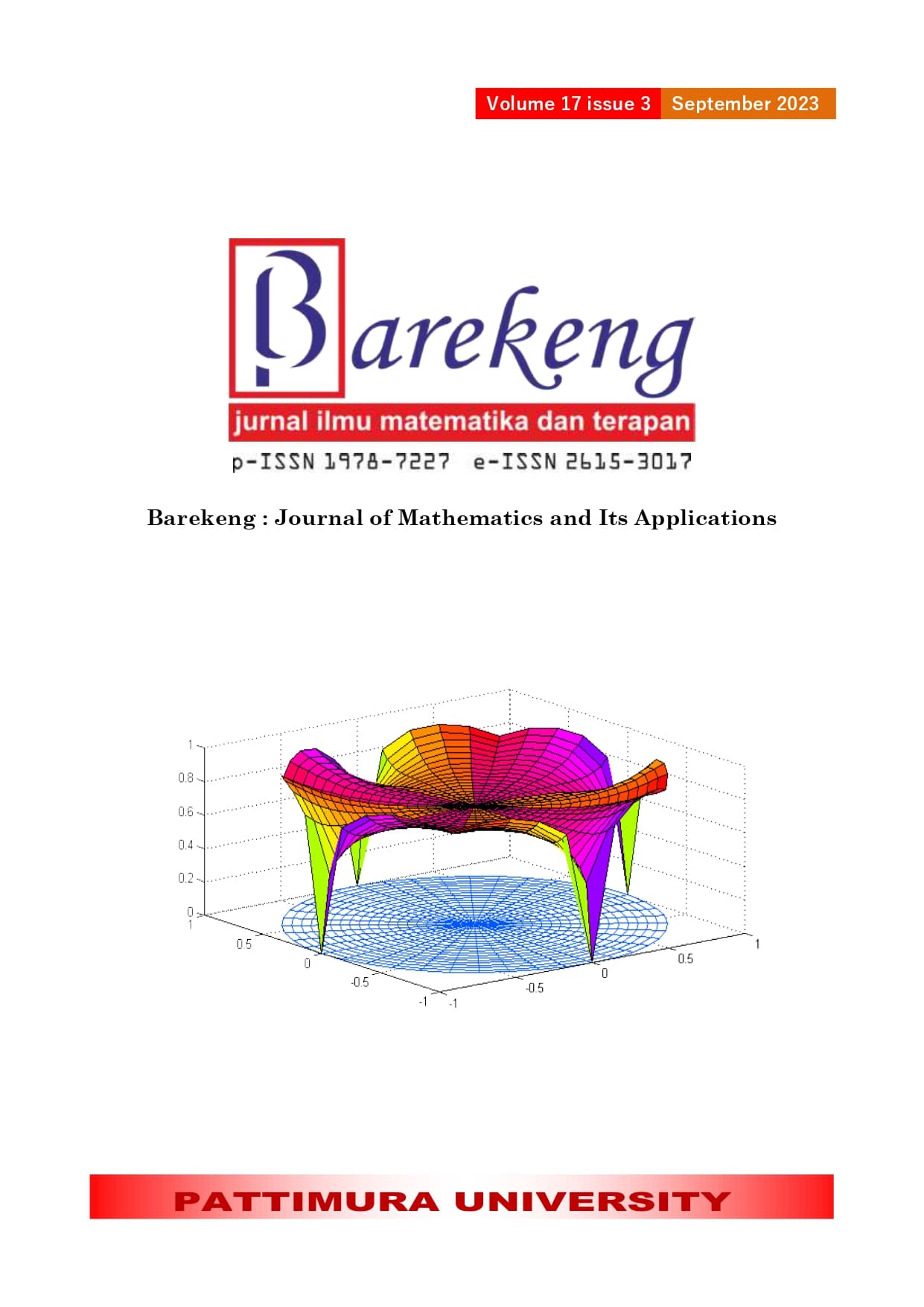DEVELOPMENT OF EXPECTED MONETARY VALUE USING BINOMIAL STATE PRICE IN DETERMINING STOCK INVESTMENT DECISIONS
Abstract
Stock investment is an investment opportunity. This stock investment carries relatively high risk and therefore requires additional analysis to minimize losses and maximize profits. Expected Monetary Value (EMV) is a simple modeling method for estimating the value of an investment that will provide the greatest future return. The expected monetary value (EMV) method involves multiplying the total value of each scenario by the probability of that scenario occurring. However this method has weaknesses in terms of how many cases occur what is the value of each case and what is the probability of each case occurring. Binomial State Price is a method commonly used to calculate stock options and real options but includes the step of modeling the value of an investment in many situations and opportunities that arise in the future. In this paper, our objective is to develop the EMV method with the binomial state pricing model to determine the investment that offers the most favorable payoff. In short, we can develop the expected monetary value (EMV) method and the binomial state pricing model. It was found that this model always recommends stocks which have high dividens.
Downloads
References
E. C. Brüggen, J. Hogreve, M. Holmlund, S. Kabadayi, and M. Löfgren, “Financial well-being: A conceptualization and research agenda,” J Bus Res, vol. 79, pp. 228–237, Oct. 2017, doi: 10.1016/j.jbusres.2017.03.013.
S. M. Focardi and F. J. Fabozzi, The Mathematics of Financial Modeling and Investment Management, 1st ed. New Jersey: John Wiley & Sons, Inc., 2004.
J. Rowena, “Earnings Volatility, Kebijakan Dividen, Dan Pertumbuhan Asset Berpengaruh Terhadap Volatilitas Harga Saham Pada Perusahaan Manufaktur Di BEI Periode,” Jurnal Administrasi Kantor, vol. 5, no. 2, pp. 231–242, 2017.
V. Veny and Y. Gunawan, “Perubahan Harga Saham Dilihat dari Faktor Fundamental Perusahaan Makanan dan Minuman,” Jurnal Akuntansi Bisnis, vol. 15, no. 1, Feb. 2022, doi: 10.30813/jab.v15i1.2874.
Romadhoni and Nurhasanah, “Analisa Expected Monetary Value Produksi Kapal Ikan Fiberglass Menggunakan Metode Decision Tree Expected Monetary Value Analysis Of Fiberglass Vising Vessel Production Using Decision Tree Method,” Journal of Economic, Business and Accounting, vol. 4, no. 1, pp. 63–69, 2020.
J. Saputri, D. Oktafalia, and M. Muzammil, “Analisis Return Portofolio yang Optimal Pada Saham LQ 45 yang Tercatat di Bursa Efek Indonesia Selama Periode,” Business & Management Journal Bunda Mulia, vol. 8, no. 1, 2008.
Y. Syukriyah and Falahah, “Estimasi Resiko Pengembangan Sistem Informasi Menggunakan Pendekatan Expected Monetary Value (EMV),” Jurnal Ilmiah Teknologi Informasi Terapan, vol. 3, no. 3, pp. 261–266, Aug. 2017.
B. Render, R. M. Stair, M. E. Hanna, and T. S. Hale, Quantitative analysis for management, vol. 13. 2021.
Suharyadi and P. S.K., Statistika untuk Ekonomi dan Keuangan Modern, 3rd ed., vol. 1. Jakarta: Salemba Empat, 2016.
“PT Bank Syariah Indonesia Tbk (BRIS.JK),” Yahoo Finance, Dec. 15, 2022. https://finance.yahoo.com/quote/BRIS.JK/history?p=BRIS.JK (accessed Dec. 15, 2023).
“PT Elang Mahkota Teknologi Tbk (EMTK.JK),” Yahoo Finance, Dec. 15, 2022. https://finance.yahoo.com/quote/EMTK.JK/history?p=EMTK.JK (accessed Dec. 15, 2022).
“PT Erajaya Swasembada Tbk (ERAA.JK),” Yahoo Finance, Dec. 15, 2022. https://finance.yahoo.com/quote/ERAA.JK/history?p=ERAA.JK (accessed Dec. 15, 2022).
“PT Indofood Sukses Makmur Tbk (INDF.JK),” Yahoo Finance, Dec. 15, 2022. https://finance.yahoo.com/quote/INDF.JK/history?p=INDF.JK (accessed Dec. 15, 2022).
“PT Japfa Comfeed Indonesia Tbk (JPFA.JK),” Yahoo Finance, Dec. 15, 2022. https://finance.yahoo.com/quote/JPFA.JK/history?p=JPFA.JK (accessed Dec. 15, 2022).
“PT Kalbe Farma Tbk. (KLBF.JK),” Yahoo Finance, Dec. 15, 2022. https://finance.yahoo.com/quote/KLBF.JK/history?p=KLBF.JK (accessed Dec. 15, 2022).
“PT Perusahaan Gas Negara Tbk (PGAS.JK),” Yahoo Finance, Dec. 15, 2022. https://finance.yahoo.com/quote/PGAS.JK/history?p=PGAS.JK (accessed Dec. 15, 2022).
“PT Semen Indonesia (Persero) Tbk (SMGR.JK),” Yahoo Finance, Dec. 15, 2022. https://finance.yahoo.com/quote/SMGR.JK/history?p=SMGR.JK (accessed Dec. 15, 2022).
“Perusahaan Perseroan (Persero) PT Telekomunikasi Indonesia Tbk (TLKM.JK),” Yahoo Finance, Dec. 15, 2022. https://finance.yahoo.com/quote/TLKM.JK/history?p=TLKM.JK (accessed Dec. 15, 2022).
“PT United Tractors Tbk (UNTR.JK),” Yahoo Finance, Dec. 15, 2022. https://finance.yahoo.com/quote/UNTR.JK/history?p=UNTR.JK (accessed Dec. 15, 2022).
J. C. Cox, S. A. Ross, and M. Rubinstein, “Option Pricing: A Simplified Approach*,” J financ econ, vol. 7, no. 3, pp. 229–263, 1979.
K. A. Sidarto, M. Syamsuddin, and N. Sumarti, Matematika Keuangan, 1st ed. Bandung: ITB Press, 2019.
S. Benninga and Z. Wiener, “The Binomial Option Pricing Model,” Mathematica in Education and Research, vol. 5, no. 1, pp. 27–34, Feb. 1997.
S. Benninga, Financial Modeling, 4th ed. Cambridge, Massachusetts: The MIT Press, 2014.
C. C. Ko, T. T. Lin, F. M. Zeng, and C. Y. Liu, “Optimum technology product life cycle technology innovation investment-using compound binomial options,” Risks, vol. 6, no. 3, Sep. 2018, doi: 10.3390/risks6030098.
S. Cruz Rambaud and A. M. Sánchez Pérez, “Assessing the option to abandon an investment project by the binomial options pricing model,” Advances in Decision Sciences, vol. 2016, 2016, doi: 10.1155/2016/7605909.
Copyright (c) 2023 Giovanny Theotista, Margareta Febe, Yvone Marshelly

This work is licensed under a Creative Commons Attribution-ShareAlike 4.0 International License.
Authors who publish with this Journal agree to the following terms:
- Author retain copyright and grant the journal right of first publication with the work simultaneously licensed under a creative commons attribution license that allow others to share the work within an acknowledgement of the work’s authorship and initial publication of this journal.
- Authors are able to enter into separate, additional contractual arrangement for the non-exclusive distribution of the journal’s published version of the work (e.g. acknowledgement of its initial publication in this journal).
- Authors are permitted and encouraged to post their work online (e.g. in institutional repositories or on their websites) prior to and during the submission process, as it can lead to productive exchanges, as well as earlier and greater citation of published works.






1.gif)



